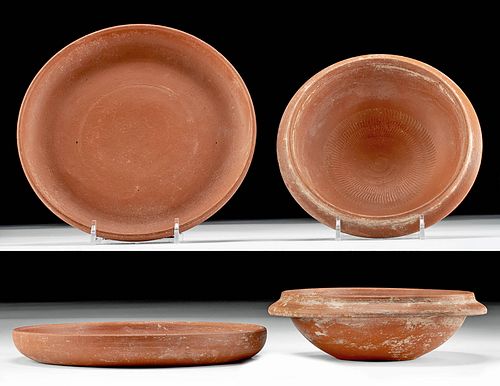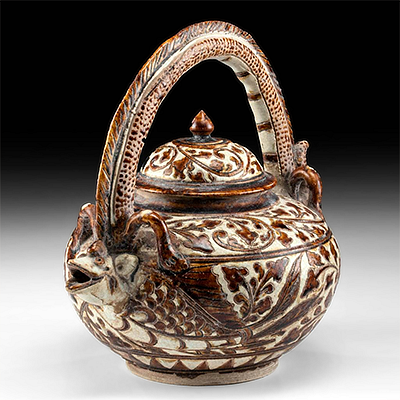Roman Terra Sigillata Dish & Bowl Set
Lot 33
About Seller
Artemis Fine Arts
686 S Taylor Ave, Ste 106
Louisville, CO 80027
United States
Selling antiquities, ancient and ethnographic art online since 1993, Artemis Gallery specializes in Classical Antiquities (Egyptian, Greek, Roman, Near Eastern), Asian, Pre-Columbian, African / Tribal / Oceanographic art. Our extensive inventory includes pottery, stone, metal, wood, glass and textil...Read more
Categories
Estimate:
$600 - $900
Absentee vs Live bid
Two ways to bid:
- Leave a max absentee bid and the platform will bid on your behalf up to your maximum bid during the live auction.
- Bid live during the auction and your bids will be submitted real-time to the auctioneer.
Bid Increments
| Price | Bid Increment |
|---|---|
| $0 | $25 |
| $300 | $50 |
| $1,000 | $100 |
| $2,000 | $250 |
| $5,000 | $500 |
| $10,000 | $1,000 |
| $20,000 | $2,500 |
| $50,000 | $5,000 |
| $100,000 | $10,000 |
| $200,000 | $20,000 |
About Auction
By Artemis Fine Arts
Jul 1, 2021
Set Reminder
2021-07-01 10:00:00
2021-07-01 10:00:00
America/New_York
Bidsquare
Bidsquare : Antiquities | Asian | Ethnographic Art
https://www.bidsquare.com/auctions/artemis-gallery/antiquities-asian-ethnographic-art-7148
Featuring classical antiquities, ancient and ethnographic art from cultures encompassing the globe. Egyptian, Greek, Roman, Near Eastern, Asian, Pre-Columbian, Native American, African / Tribal, Oceanic, Spanish Colonial, Russian, Fossils, Fine Art, more! All legally acquired, legal to sell. Artemis Fine Arts info@artemisgallery.com
Featuring classical antiquities, ancient and ethnographic art from cultures encompassing the globe. Egyptian, Greek, Roman, Near Eastern, Asian, Pre-Columbian, Native American, African / Tribal, Oceanic, Spanish Colonial, Russian, Fossils, Fine Art, more! All legally acquired, legal to sell. Artemis Fine Arts info@artemisgallery.com
- Lot Description
Roman, North African, 3rd to 4th centuries CE. A charming, mold-made terra sigillata bowl and dish with a characteristically rich red finish featuring a minimalist decoration adorning their tondos. The dish is made with a flat-bottom and features a broad, shallow basin surrounded by a sloped, flared rim, and wheel-cut striations along its center. The bowl has a thick double-lipped rim along its exterior, a modest relief with a light tondo, and nice earthen deposits scattered across its surface. North Africa was one of Rome's wealthiest provinces. This type of pottery is also known as African Terra Sigillata or Samian ware, referring to the method used to seal the red slip onto the pottery during the kilning process. These objects were mold made and traded far and wide. Size of dish: 7.5" Diameter (19 cm) Size of bowl: 6.25" Diameter x 2" H (15.9 cm x 5.1 cm)
Terra sigillata is a fine type of Roman ceramic coveted for its smooth red slipped finish and intriguing relief decoration. According to the Walters Museum, "The vessel and decorations were formed in a mold and were sometimes embellished with stamps, roller-dies, appliques, barbotine, and incision. This type of pottery originally emerged around 40 BCE in Arretium (modern Arezzo) in central Italy and had an enormous influence across the Empire, especially in North Africa were the method was further developed and altered."
Provenance: ex-private Toluca Lake, California, USA collection; ex-Malter Gallery auction, June 14, 1998, lot 221, Encino, California, USA
All items legal to buy/sell under U.S. Statute covering cultural patrimony Code 2600, CHAPTER 14, and are guaranteed to be as described or your money back.
A Certificate of Authenticity will accompany all winning bids.
We ship worldwide and handle all shipping in-house for your convenience.
#164390Minor chipping along outer lip of bowl. Otherwise, fully intact and in excellent condition. Nice earthen deposits scattered throughout.Condition
- Shipping Info
-
All shipping is handled in-house for your convenience. Your invoice from Artemis Gallery will include shipping calculation instructions. If in doubt, please inquire BEFORE bidding for estimated shipping costs for individual items.
-
- Buyer's Premium



 EUR
EUR CAD
CAD AUD
AUD GBP
GBP MXN
MXN HKD
HKD CNY
CNY MYR
MYR SEK
SEK SGD
SGD CHF
CHF THB
THB
















